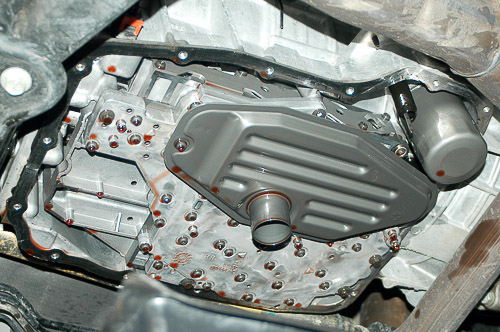
Since most owners will not rebuild their Jeep’s automatic transmission, this section focuses on the routine maintenance and service of the typical Jeep automatic transmission. You should perform these service procedures at regular intervals.
For the Jeep 4×4 driven at a crawl pace off-pavement,odometer mileage is not the criterion for fluid changes. At my Camp Jeep (Mopar) workshops, I ask Jeep owners to consider thehours of service that their Jeep transmission has provided. Low-range driving in a TJ Rubicon willquadruple (4:1 low range ratio) the actual shaft rotations for the engine and transmission. YJ and TJ models with the NP/NV231 transfer case will increase the engine and transmission usage by 2.72 times while operating in low range. Adjust your Jeep 4×4’s service intervals accordingly.
Mopar performance buffs will readily recognize the A-999 and 30/32RH transmission types. These transmissions are each relatives of the time-honored A-904 transmission. The A-904 Torqueflite, three-speed automatic dates to the muscle car era. This unit is not quite as famous as the A-727 Torqueflite that backed up everything from truck and motorhome 413 and 440 V-8 engines to the 14-second quarter mile 440 wedge-head V-8 cars and even the legendary 426 Hemi V-8. The A-904 served in full-size and intermediate sized cars of considerable weight, however, models with lesser horsepower engines. This included the inline sixes, 318 V-8 and even some 340 and 360 V-8 applications.
So, how does such a transmission turn up in a Jeep 4×4 utility vehicle? Long before the Chrysler and DaimlerChrysler ownership of Jeep Corporation, AMC/Jeep recognized the value of Chrysler automatic transmissions. The horse trailer toting Grand Wagoneer 360 V-8 got the A-727 Torqueflite, while the much lighter weight CJ-7 models switched from the GM THM400 to the A-904/999 Torqueflite in 1980. Commitment to quality Chrysler automatic transmissions survives through the YJ and TJ Wrangler era!
The A-904 and lock-up converter version A-999 are similar with regard to their routine service needs. The 30/32RH unit also shares many design features with the time-honored A-904/999. Basic architecture of the A-904 and ‘999’ transmissions survives in the 30/32RH automatics offered through the 2002 model TJs.
Caution—Many of the parts do not interchange between the 30/32RH and earlier 904 or 999 units. There are case, fluid passageway, valve body, shaft and electronic PCM interface components that distinguish the 30/32RH series transmissions from the 904/999 types. If rebuilding a 30RH or 32RH unit, use the components designed for each of these units.
Note—Advance Adapters currently makes swap hardware to enable use of the 999 transmission with a small-block GM V-8. There is also the option of using a Dodge ‘LA’ 5.2L V-8 with the A-904 (a more rugged V-8 version) or 999 type transmission. This would require a small-block Dodge V-8 transmission case and input pieces mated to Jeep internal and output components. In good condition, these transmissions hold up well with horsepower in the 180-230 range. 1960s 2-barrel 318 V-8s rated at 230 horsepower were often coupled to the A-904 (V-8 version) in full-size Chrysler cars! AMC coupled the A-904 to 304 V-8s and even some smog-era, lower horsepower 360 V-8s. (V-8 applications have factory upgraded clutch packs and internal components.) Do not underestimate this transmission—the Mopar Performance Catalog contains pages of high performance upgrades available for the A-904/999 transmissions!
With the need for an overdriving four-speed automatic, the 2003 and newer TJ Wrangler acquires the 42RLE unit. The 42RLE is also a proven design. A four-speed that gains from the quality engineering found in classic Torqueflite three-speed automatics and the rugged RE-series overdrive units, the 42RLE and similar RFE or RLE automatics serve in various Jeep Grand Cherokee and Liberty models. These four-speed units hold up very well, especially at the stage of refinement reached by 2003 when Jeep first offered the 42RLE on the TJ Wrangler option list.
Note—One distinct advantage of the 42RLE is its gear ratios: 1st/2.84:1; 2nd/1.57:1; 3rd/1.00; 4th/0.69:1 and reverse 2.21:1. These are low first and reverse ratios and very useful in low-range or under compression braking situations. Compare this to a 1.74:1 first gear in the 999 units.
The service needs of the 904/999 and 30/32RH are in several ways similar. Actually, the things that wear out an automatic transmission are not four-wheeling in low range or high speed highway use. Automatic transmissions fail prematurely from overheating, low fluid (including aeration/starvation) or neglect. There are ways to safeguard against each of these concerns:
1) Overheating an automatic is generally caused by poor fluid quality, a partially clogged cooling system or transmission cooler, or an engine radiator that runs overly hot. Keep the cooling system in good condition. Make sure fluids are clean and red in color.
2) Change and check fluid regularly. Aeration is normally due to low fluid or a loose/leaking filter seal at the valve body or case. Keep fluid at the hot/full level as described on the dipstick. Another cause of aeration is tilting the vehicle on an angle so steep that transmission fluid cannot stay in line with the transmission oil filter/pickup. Always change the filter and pan gasket with each fluid change.
3) Bands, linkage and switchesneed attention. On 904/999 and 30/32RH* transmissions, band adjustment is a periodic service. Linkage, cables and electrical switches control starting, downshifts, passing gear, upshift quality and even the ability to shift out of Park (on later models). Before condemning the transmission unit as defective, consider these far simpler possibilities.
*For a PDF download copy of the 30RH and 32RH factory adjustment procedures, covering all possible adjustment needs, click here.
Clean and properly cooled fluid, proper downshift (throttle pressure) and shift linkage adjustments and periodic service, including band adjustments where required, will keep an automatic transmission in good shape. Periodic service is the focus of this section, a review of YJ/TJ Wrangler automatic transmission needs. Read through and decide whether you want to do this light service work yourself or sublet the tasks to your local Jeep dealership.

A-T 1: The strength of Chrysler transmissions is characterized by the A-727 Torqueflite used in Jeep Grand Wagoneer and J-truck models. This three-speed automatic design withstood the 425-plus horsepower poundings of two-ton, 426 Hemi-powered muscle cars in the 1960s. AMC/Jeep was wise to adopt this J-model option for the 1980s. The A-727 served right through the final 1991 Jeep Grand Wagoneer models.

A-T 2: More compact A-904, 999 and 30/32RH units found in CJ, YJ and TJ Jeep 4×4 utility models are lighter-duty versions of rugged Torqueflite technology. The 30RH (shown) and A-904 serve four-cylinder applications. Found in YJ and TJ Wranglers of the mid-‘90s to 2002 era, the 30RH has a lock-up torque converter. The PCM (powertrain control module) switches and solenoids play a role in shift and lock-up functions. With hard parts and a fundamental design dating to the early 1960s, the A-904 and ‘999’ withstood the test of small-block V-8 engines in full-size cars and light trucks. This is surely a substantial transmission design for 4- or 6-cylinder Jeep YJ or TJ 4x4s! The only drawback is no overdrive.
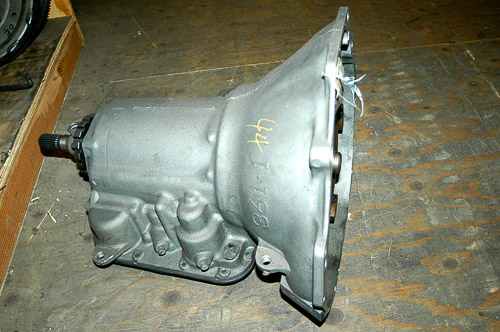
A-T 3: Right side view reveals pressure test plugs for troubleshooting at the professional level. Note the compact, overall neatness of the 904/999 and 30/32RH design. This is a transmission length tailored to rear-drive vehicles in the shorter, 94-inch wheelbase range—like the CJ-7, YJ and TJ Wrangler!

A-T 4: The left side of the 30/32RH units reveals a feature common to the 904/999 family of Chrysler transmissions: the front or “kickdown” band adjustment. Yes, all 904/999 and 30/32RH transmissions require periodic band adjustment.Many technicians and owners are unfamiliar with the needs of traditional Chrysler transmissions, and these two band adjustments get overlooked. The result can be a complete transmission failure and need for rebuilding due to slippage and poor performance, all of which might easily have been avoided.
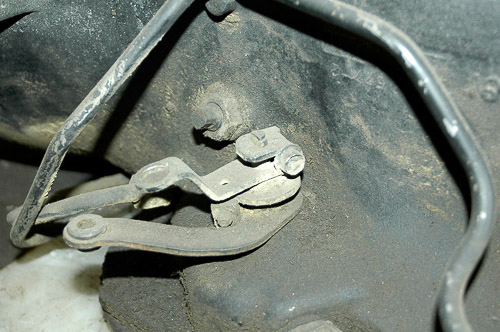
A-T 5: The A-727 Torqueflite also has front and rear band adjustments. Our ’87 Grand Wagoneer, purchased at 84,000 miles in top condition, was in need of a band adjustment. I knew this not from any signs of slippage. There was a slight delay when shifting into reverse or 1stgear position from neutral. The rear band needed its routine adjustment, and adjusting the front and rear band with a fluid and filter change restored performance to like-new shifts. We drove and enjoyed the vehicle for another 50,000 miles then sold it with the transmission still shifting flawlessly.

A-T 6: By comparison, the Aisin-Warner AW-4 automatic popularized in the XJ Cherokee models has no band adjustment feature. These units hold up well and serve behind high-output 4.0L engines in the 190 horsepower category. They were not used in the YJ or TJ Wrangler for one obvious reason: The transmission is long and therefore ill-suited for the 93.4-inch wheelbase YJ/TJ Wrangler. The XJ Cherokee’s 101.4-inch wheelbase makes the XJ a good candidate for the four-speed overdrive AW-4.
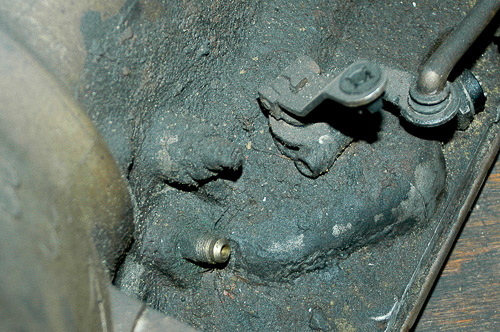
A-T 7: Should you decide to adjust the bands on a YJ or TJ automatic transmission, take dirt into consideration. Here is the adjuster and lock nut on a typical higher mileage Jeep 4×4 used off-pavement. Use a pressure washer or steam cleaner to clean around this adjuster and eliminate risk of getting a false torque reading when you tighten the front band. The rear band adjuster, accessed with the oil pan dropped, should be clean and oily from ATF, ready for adjustment!
Typical Band Adjustment Procedures
Band adjustment requires a model-specific set of tightening and adjusting specifications. The factory shop manual describes specifications for band adjustment on particular model year 904/999 and 30/32RH transmissions. Confirm the specifications for your YJ or TJ’s transmission. The procedure for adjusting bands is similar for YJ and TJ Wrangler transmissions.
These general steps will help if you need to make field adjustments or when performing a routine band adjustment:
1) Clean the area around the front band adjuster thoroughly. Dirt and debris will cause drag on the adjuster screw and erroneous torque readings.
2) Loosen the lock nut that secures the adjuster. The nut and adjuster screw should be backed off several turns to confirm that the band is loose enough(example: 3-5 turns for the 30 or 32RH units). Make certain that the adjuster screw turns without friction.
3) Tighten the adjuster screw to 72 in-lbs (6 ft-lbs) on the 30/32RH. This will fully seat the band.
4) Back off the adjuster precisely the number of turns specified.(Example: 2.5 turns for the 30RH; 2.25 turns for the 32RH.)
5) Hold the adjuster screw steadily as you tighten the lock nut.(Example: On the 30/32RH unit, lock nut torque is 30 ft-lbs.)
6) With the oil pan dropped, you can adjust the rear band. Again, back off the adjuster, this time 5-6 full turns. The adjuster screw should now turn easily in the lever threads.
7) There are different screw-tightening specifications for these transmissions.For example, the 30RH (41 in-lbs) differs from the 32RH (72 in-lbs).
8) With the screw tightened to the in-lb torque specification, the amount of adjuster screw back off also differs between models. Example: 7 turns on the 30RH; 4 turns for the 32RH.
9) Tighten the rear band lock nut while holding the adjuster steadily.(Do not allow the adjuster to rotate as you tighten this nut.) On the 30RH and 32RH, this specification is 25 ft-lbs.
10) Install a new filter, gasket and the cleaned oil pan. Tighten pan bolts with your torque wrench to 13 ft-lbs (156 in-lbs).
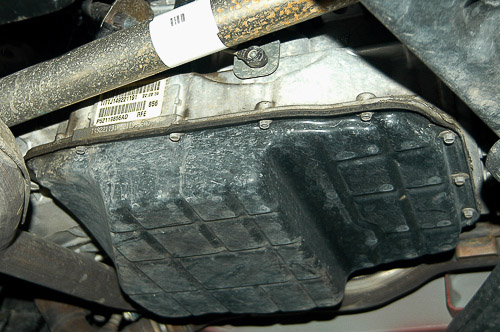
A-T 8: A common service is the oil filter and fluid change. This process begins with cleaning around the oil pan. Automatic transmission work requires a conscientious effort to keep parts clean. Contamination of the valve body or interior of the transmission can ruin an automatic transmission’s performance.
Caution: When I schooled at automatic transmission rebuilding in 1969, the buzzwords were “lint-free” rags and 100-mesh screening. Hands, tools, the area around the oil pan and any new parts introduced to the transmission must be thoroughly clean and dirt-free. Keep shop rags and lint away from the valve body!
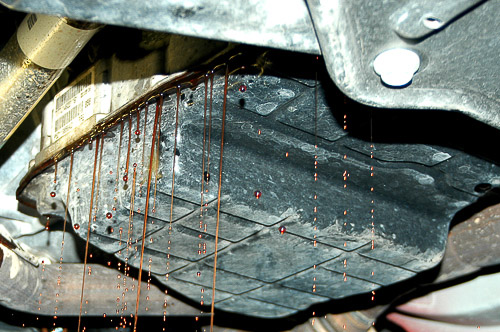
A-T 9: With the transmission clean and a large drain pan in place beneath the oil pan, loosen the oil pan bolts. Leave two opposing bolts in place to stabilize the pan then gradually loosen these two bolts. When the pan gasket seal breaks, expect fluid to gush over the sides as in this later Jeep automatic’s example. There is never any sealant on the gasket, so it should not take much effort to loosen the oil pan. The transmission case is aluminum. If you must pry at all, make sure to do so between the gasket and pan—not at the expensive aluminum transmission case’s edge!

A-T 10: This late Jeep example of a 45RFE transmission (non-adjustable band type) reveals two oil filters. The 42RLE has only one filter, the common flat type filter traditionally found on automatic transmissions like the 904/999 and 30/32RH. The 45RFE uses an additional spin-on oil filter similar in design to an engine oil filter unit. Neither the 42RLE nor this 45RFE requires band adjustments, as these units do not use bands. They each feature four multi-plate clutch apply packs instead.
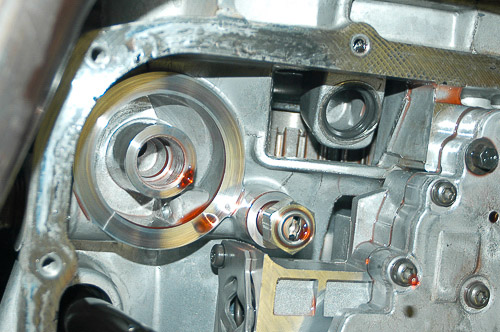
A-T 11: On the RFE, there is a spin-on filter. The more conventional filter also employed has a stem pipe that fits into the oil seal and hole to the right of the spin-on filter and near the oil pan rail. When the oil filter comes with a seal or gasket, replace the oil seal. Follow directions that come with the filter. Never use sealant of any kind on the stem pipe, seals or pan gasket of an automatic transmission. If sealant were to enter the valve body, easy enough with the filter removed, the finely machined valves and accumulators would stick and malfunction.
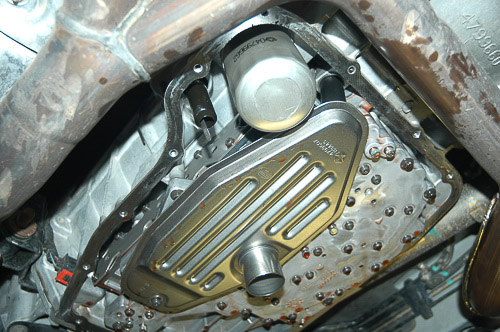
A-T 12: In this general illustration of the 45RFE filters, you can see that the conventional (non-spin-on) filter has a retaining screw. This is common to the Jeep filters. Secure this screw adequately but do not over-tighten it. Stripping valve body threads could prove costly and time consuming to remedy. These ordinary looking screws have a torque specification. Check the instructions that come with the new filter or consider 36-48 in-lbs (3 to 4 ft-lbs) enough. Screw driver snug or 4 ft-lbs, in other words. Tighten, wait a few minutes and recheck torque before installing the oil pan.
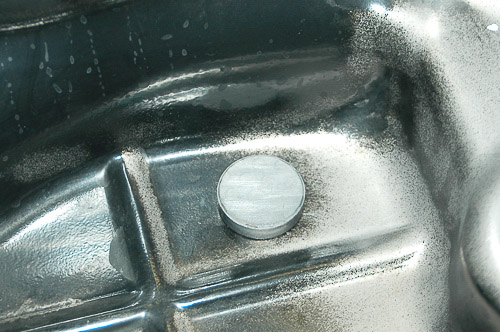
A-T 13: Chrysler uses a magnet in the oil pan to concentrate any ferrous debris. Normal wear will show as very tiny metal debris at the magnet. Clean the magnet off and install it in exactly the original location. Heavier metal or burnt, blackish and acrid fluid is a bad sign and could indicate an automatic transmission in need of overhaul—now or very soon.
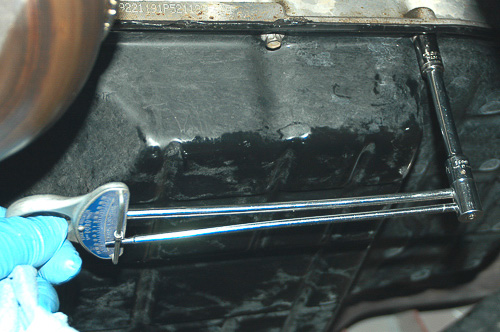
A-T 14: Install the oil pan with a new gasket—do not use sealant. Tighten bolts gradually and in steps. Final torque on this pan’s bolts is 13 ft-lbs. Specifications should be found in the Mopar gasket and filter package. I always use an Authentic Mopar filter and pan gasket on Jeep transmissions. See your Jeep dealer’s parts department.
Caution: Some late Chrysler transmission oil pan gaskets are reusable. They will say so on the gasket. If not, install a new gasket…Align the pan, start bolts carefully and torque properly.
There are other service details that you can address. On vehicles used in the backcountry around trail debris, the shift linkage and cable adjustments can suffer. Strange lever alignment, mushy or harsh shifts and downshift problems can be cable and linkage related. Linkage trouble can also cause difficult movement out of the “Park” or “P” position.
While these adjustments can be performed using a model-specific Jeep factory shop manual, you may be inclined to have your local Jeep dealership’s transmission specialist perform these tasks. As an automatic transmission professional, I know that the dealership’s specialist will be familiar with model-specific symptoms or common trouble areas. The specialist will also test your vehicle’s performance on the road. While these transmissions have tremendous stamina, they do need periodic service, adjustments and troubleshooting for brewing problems.
Know, too, that the engine’s cooling system is part of the transmission’s cooling package. Keeping an automatic transmission cool requires clean fluid and a radiator that works properly.
In addition to periodic service and regular fluid and filter changes, keep the engine and transmission cooling system in top condition. Use low range in rock crawling situations to take a load off the torque converter. This will dramatically reduce heat buildup. Other ways to preserve an automatic transmission are to use Mopar filters and the Mopar recommended ATF fluid type.
Serviced routinely and properly, your 904/999, 30/32RH or 42RLE transmission will give many years of quality service. Automatic transmissions are much a part of today’s four-wheel drive scene, and the Chrysler automatic transmission designs meet world class standards. Enjoy your YJ or TJ Wrangler equipped with an automatic transmission!
While rebuilding aChrysler-design automatic transmission does not require extensive equipment, most owners find that an exchange transmission unit makes good sense. At present, of the three transmission types available for Jeep YJ and TJ Wranglers, the 42RLE is within thefactoryChrysler-Mopar(Jeep)Remanufactured Partsprogram.
Local rebuilders, Jeep dealershipsand automotive parts retailers can also supply exchange transmission units, rebuild kits and rebuilt torque converters. Mopar offers rebuilt front pump units, torque converters and some valve bodies for Jeep transmissions. See your local Jeep dealer for Authentic Mopar parts.
Mopar Performance also offers stamina upgrade and high performance components for the A-904/999 unit. Shift improvement kits, performance shift linkage, transmission add-on coolers, a deep sump oil pan and deep-sump filter kits are available through Mopar/Jeep. Your local Jeep dealer can also supply Mopar ATF fluid, OE replacement filters and pan gaskets.
Note: I have taught automatic transmission rebuilding, and am willing to demonstrate a step-by-step teardown and complete rebuild of the Jeep Wrangler 999, 30/32RH or 42RLE transmission—if there is enough interest in the topic. When pursuing automatic transmission rebuilding, YJ/TJ owners or smaller shops must be willing to invest in the tools needed to test and overhaul an automatic transmission.
********************
Copyright 2010 © Moses Ludel…Enjoy this comprehensive, color-illustrated article and photography by Moses Ludel. The article is available solely at the4WD Mechanix Magazine website and can be viewed here as often as you like. If you wish to share the article with friends or professional colleagues, please refer them to the 4WD Mechanix Magazine website:
As copyrighted material, this article and the photography cannot be copied or distributed in any other form.—Moses Ludel
